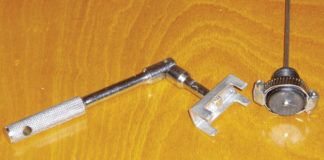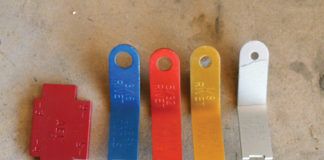Our staff has been to AirVenture, eaten bratwurst, swatted mosquitoes and generally had a really good time. We found a few new items we think merit our coveted Gear of the Year designation, a catch-all for neat things-products, current and future, germane to hard-working homebuilders. Here are our nominees for 2008.
Stewart EkoPoxy
Stewart Aircraft Finishing Systems introduced EkoPoxy, a new waterborne two-part catalyzed epoxy primer that also contains a proprietary corrosion inhibitor. No oxidation, no rust, no toxic vapors. Pretty cool. Oh, and its tough enough to resist a pretty good thumb dig into a coated fabric surface. (It recovered shortly thereafter.)
Company principal Doug Stewart told us EkoPoxy was developed to protect the metal fuselage and any steel parts from corrosion. Its an extremely durable, tough paint, and were trying to keep those metal airplanes from rusting he said. With a lot of primers, you have to be very careful what type of paints you put over them because they dissolve them. This primer is impervious to just about anything we can throw at it: MEK, lacquers, all your high-solvent rubs, even long-term exposure in warm saltwater or salt air. Good news if your planes on floats, or if you tie it down in a salty environment.
EkoPoxy is also STCd, and the company is working on getting its paints Mil-Specd. We work to a higher standard, Stewart said. Were the only fabric and paint system in the industry thats totally non-hazardous, meets all OSHA EPA requirements and is noncombustible. You can use it indoors in a closed-room environment all day with no health or hazard issues. Its a catalyzed product that doesn’t require a fresh-air breathing system. Its safe to use-we just require a good quality charcoal respirator. And you’re not going to blow your shop up because it will absolutely not burn in a liquid or a cured state.
Stewart noted that this technology has been around for about 14 years, and that solvents are on their way out. The company can ship the materials worldwide with no hazmat or special shipping requirements. He added that they hadn’t received any reports from the field about cracking or crazing on fabric aircraft.
EkoPoxy can be cleaned up with water, and is available now. Check out the Stewart Aircraft Finishing Systems web site at www.stewartsystems.aero for more information, or call the Cashmere, Washington, facility at 888/356-7659.
Aveo RockRack
Settled quietly next to the dazzling display of AveoFlash LED aircraft lights, AveoEngineerings selection of aircraft cockpit rocker switches demonstrated its own brand of brilliance. Called RockRack, this innovative modular system allows you to set up your dash as you wish. The sleek curved modules lock together with a dovetail design, and are backlit with LEDs to enhance readability in both bright and overcast conditions.
Available since July 27, RockRack offers 21 different backlit icons, including master switches, each lighting circuit, fuel pump, alternator and weather. Each switch takes 20 amps, is available in 12 or 24 volts, and includes integrated resistors. They have a mechanical life of 150,000 cycles, so rock away. A pack of eight switches goes for about $286 from Aircraft Spruce (www.aircraftspruce.com), and can also be installed in certified aircraft.
Beyerdynamic DANR
Beyerdynamic debuted its HS 600 DANR (digital adaptive noise reduction) headset at AirVenture, and started a small run on the product by offering a discount to the first 50 test pilots. It goes without saying that those 50 spots were taken up quickly.
The HS 600 breaks some new ground in ANR technology. Using proprietary software, a microprocessor in the headset adapts to the noise level in the cockpit and reduces background noise. The digital design will allow product updates to be accomplished as needed.
The HS 600 was slated to go on sale at the beginning of October for $699 to $749. Beyerdynamic plans to offer the Manufaktur-Build Your Own program for the HS 600 DANR soon. Using the wizard on the company’s web site (www.shop.beyerdynamic-usa.com), you can select the color of the ear cups, ear pads, headband and aluminum design parts. You may also have text printed onto a metal plate on the headset. For more information, call 239/283-7880 or visit the web site -Cory Emberson
SPOT On
It was difficult to wander the grounds of AirVenture this year without spotting, er, SPOT signs. Indeed, in celebration of the company’s big product launch, EAA members at the show could avail themselves of a free SPOT unit with the purchase of a years subscription to its satellite services.
The SPOT handheld satellite tracker is akin to a personal locator device, but with bonus features and a low price. The simple, rugged, water-resistant design is intended for use by everyone from outdoor enthusiasts to pilots, who want the option of keeping friends or loved ones apprised of their whereabouts. With a single push of one of three buttons (plus an on/off), SPOT users can send a pre-designated text message to a given distribution list, summon 911 help to a specific location via the provision of GPS coordinates to emergency service providers, or simply send an OK message to a cell phone or an email address-all using a combination of the GPS satellite system and SPOTs satellite network. The company says at least a dozen lives have been saved worldwide since the product was introduced last fall. As pilots look toward something more reliable than the required 121.5 MHz ELT and eye the more expensive 406 MHz units, SPOT offers a secure alternative in an attractive, lightweight package.
SPOT weighs 7 ounces, runs on two AA 1.5-volt lithium batteries and will last up to two weeks when continually transmitting tracking information (seven days in 911 mode). New features may be added as the product develops. The retail price is $169.99, and the basic satellite subscription is $99 per year (includes 911 alerts, check-in and requests for help). The tracking upgrade option, which sends and saves your location and allows contacts to track your progress on Google Maps, is $49.99 annually. Unit activation and other customer services can be found at www.findmespot.com. -Mary Bernard
X-Deck Platforms
Working around the vertical stab of my Zenith, especially the upper parts, requires a ladder. And therein lies the rub: Ladders aren’t especially stable under the best of conditions. Combined with a case of butterfingers, its probable that a dropped tool will leave a permanent reminder of your work on your aircraft. Sure has on mine.
So I was pretty excited to see the X-Deck line of work platforms at AirVenture, taking the whole ladder concept to…uh…new heights. I monkeyed a bit with a small, affordable model that provides 4 feet of platform, supports 1200 pounds, and adjusts to four different heights from 16 to 42 inches. It erected from its flat, folded position in less time than it takes to mention it, similar to setting up an ironing board. When it was sitting on its wide feet, there was plenty of room for two guys to comfortably work with solid footing. Weight? Only 24 pounds.
Moving the X-Deck around the hangar is easy with the two wheel sets that retract whenever there’s anything or anyone providing a load. When not in use, the X-Deck folds flat for storage. With a pair of larger X-Decks and a connecting board, its easy to create a work platform that can go over a fuselage and allow access from either side. X-Decks come in a variety of deck widths and heights, and the big ones have even been pressed into service as instant performance stages. They’re not cheap, as the smallest one runs just under $400. But after considering what bodywork and paint cost, Im thinking the X-Deck is a worthwhile addition to the hangar.
For more information, call 866/449-7787, or visit www.safeplatforms.com.
Innovative Parts Carts
The folks from Innovative Tools and Technologies have recognized that their line of Parts Carts, originally developed for the automotive repair and bodywork industry, are also ideal for aircraft builders and mechanics. Having adapted rolling bakers racks into parts storage and built more than a few wood work tables, Im amazed that its taken this long for someone to finally fill this need. And the Innovative Parts Cart does it well.
Available in a wide variety of sizes and models, the Parts Carts all feature heavy-duty locking casters, fold flat and nest neatly for storage while not in use, and can be customized with optional shelves and accessories to fill exacting needs. One model features heavily padded vertical posts on the back, ideal for storing flight-control surfaces or even small horizontal or vertical stabilizers off the airframe.
One item that caught my eye was the folding, heavily padded stand that was designed to support auto doors during repair or bodywork. Two of these would be ideal for supporting a wing during closing or while under repair, as they’re designed to gently support curved surfaces without marring or denting. Cost? About $200 each. The cost of the Parts Carts without additional options are from less than $300 to more than $500 per unit. If you have priced the cost of rolling shelving, casters or lumber lately, I think you’ll agree that the Innovative Parts Carts provide an elegant, portable, cost-effective solution for safely storing aircraft parts.
For more information, call 866/438-4884, or visit www.innovativetools.com. -Rick Lindstrom
Bendix/King AV8OR
Maybe Ive attended too many AirVentures, but for me the big buildings seemed to be full of the same thing theyve been full of the last several years: weather-planning systems, EFISes, systems that automate checklists, record variations in tire pressure and make coffee. Nothing much new…well, there was one cool little item.
Bendix/King introduced its AV8OR. Its a neat little handheld unit that puts XM weather in the cockpit, provides GPS navigation with the usual features and even includes a music, movie and eBook player, all driven through a touchscreen. There’s an automotive database, too. At $795, it costs a lot less than a Garmin 496. Finally, there is competition in this category. (Yes, I know XM weather has been available on various tablet computers and PDAs, but Im an all-in-one kinda guy.) For more information, visit www.bendix/king.com.
The Ecoflyer
Called the worlds largest LSA, the Ecoflyer caused a lot of amused looks. After a brief perusal, I wasn’t laughing. Think of a Scamp travel trailer with wings and a Rotax. There’s room for two to sleep, cook and play cards inside, using the flip-over front seats and an onboard folding table. Supposedly it weighs just 750 pounds empty. Its not fully developed, but its simple and clean-and, as if to prove the idea viable, there were two of them flying at the show. For more information, call 819/536-5353, or visit www.exploreraero.com.
– Ishmael Fuentes
Lycoming IO-233
I had heard that Lycoming was working on an antidote to the Rotax 912 and venerable Continental O-200 for Light Sport aircraft, but seeing the IO-233 in the flesh was a surprise. At first glance, the engine doesn’t look all that much different from garden-variety O-235s, once you get past the sectioned starter gear ring, spun by a lightweight Sky-Tec starter. But, says Lycoming, much of the interior has been lightened despite the move toward hydraulic roller lifters-remember that the O-235 has solid lifters and needs a valve-lash adjustment from time to time.
Fuel delivery is to be provided by what appears to be a variation on the Posa carburetor, which is a floatless, slide-throttle device with a metering needle that adjusts fuel flow relative to throttle position only. This is a simple and light carburetor though not nearly as sophisticated as even the Bing motorcycle carbs used on the Rotax 912. Frankly, Id be surprised to see this system make production. More likely is the simplified electronic ignition, using a fixed timing map and the basic architecture of the P-Mag system.
Regardless, Lycoming says the weight differential to a Rotax is around 50 pounds-call it just over 200 for the 233, about the same as the new lightweight Continental O-200-which makes it a solid improvement over the O-235. So, why do I care about little engines like this? As fuel prices continue to climb, the future of homebuilding will no doubt become more interested in economical aircraft. You get there either with improved fuel specifics or by using smaller engines. Vans has been grumbling that most RV-9 builders are opting for 160 or even 180 horsepower, when the airplane was designed to be happy on 115. Maybe the time builders start to listen is coming.
Lycoming TIO-360
The TIO-360 is very much like the Superior TIO-360, turbonormalized engine that was briefly offered exclusively to Lancair. (These days Lancair has bigger fish to fry, and Superior is, as this is written, in the throes of being purchased.) Lycomings VP of Engineering, Mike Kraft, talked to me about the engine, and said that many of the cool things about it aren’t evident from the outside, including an efficient, internally baffled intercooler carefully sandwiched between the turbo outlet and the Precision throttle body. He was proud that Lycoming will approve the engine for use on unleaded 91/96UL avgas and is looking into approval for certain types of auto gas.
It is a tidy installation, sure, and will be offered through the Thunderbolt line of aftermarket engines to the Experimental world. I take this as a good sign: Lycoming is recognizing that our world needs more than subtly juggled production engine variants, and that the market will welcome and absorb some new technology. The bottom-line question will, as ever, be price: Lycoming isn’t saying because the program is new, but with a non-turbo IO-360-M running more than $30,000 from the Thunderbolt program, Id peg the turbo engines price north of $40,000, anticipating the cost of the turbo, intercooler, fixed-point controller and associated oil-system add-ons.
More information can be found at www.mytbolt.com. -Marc Cook













